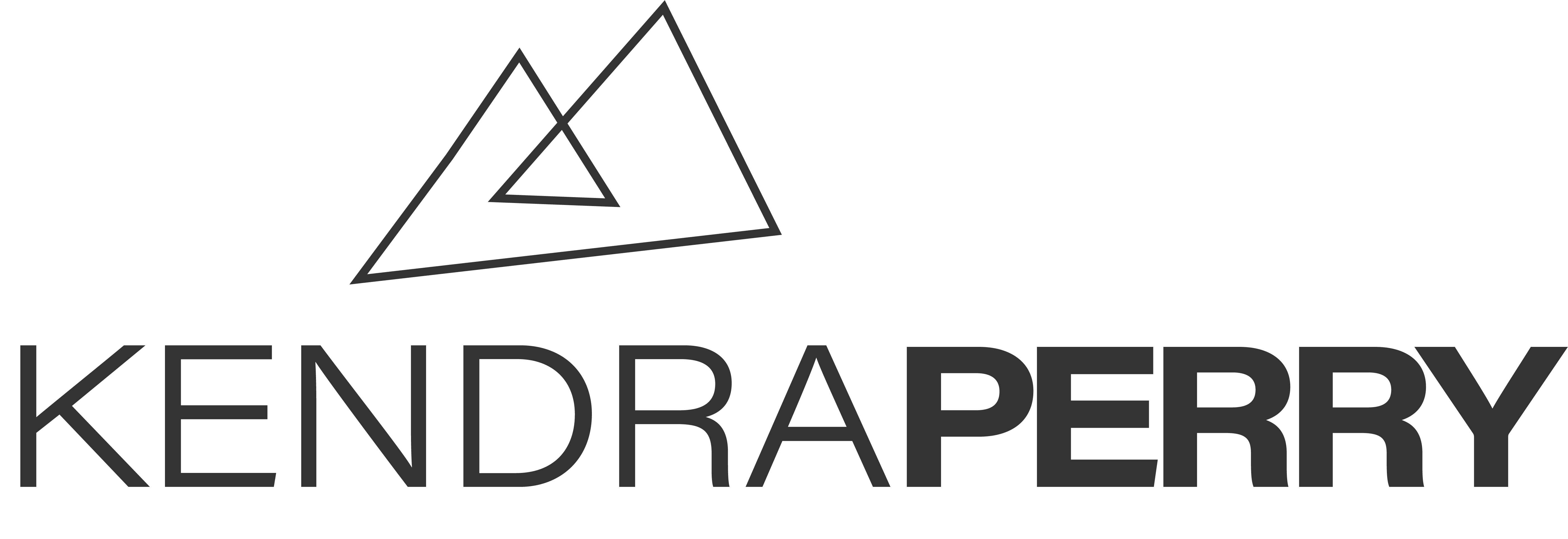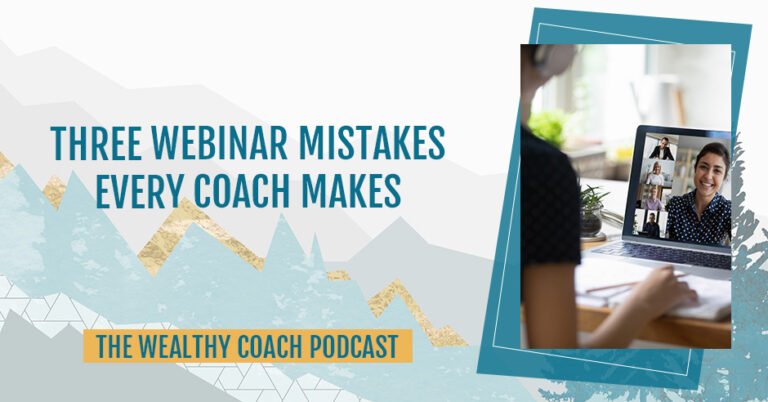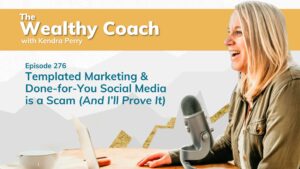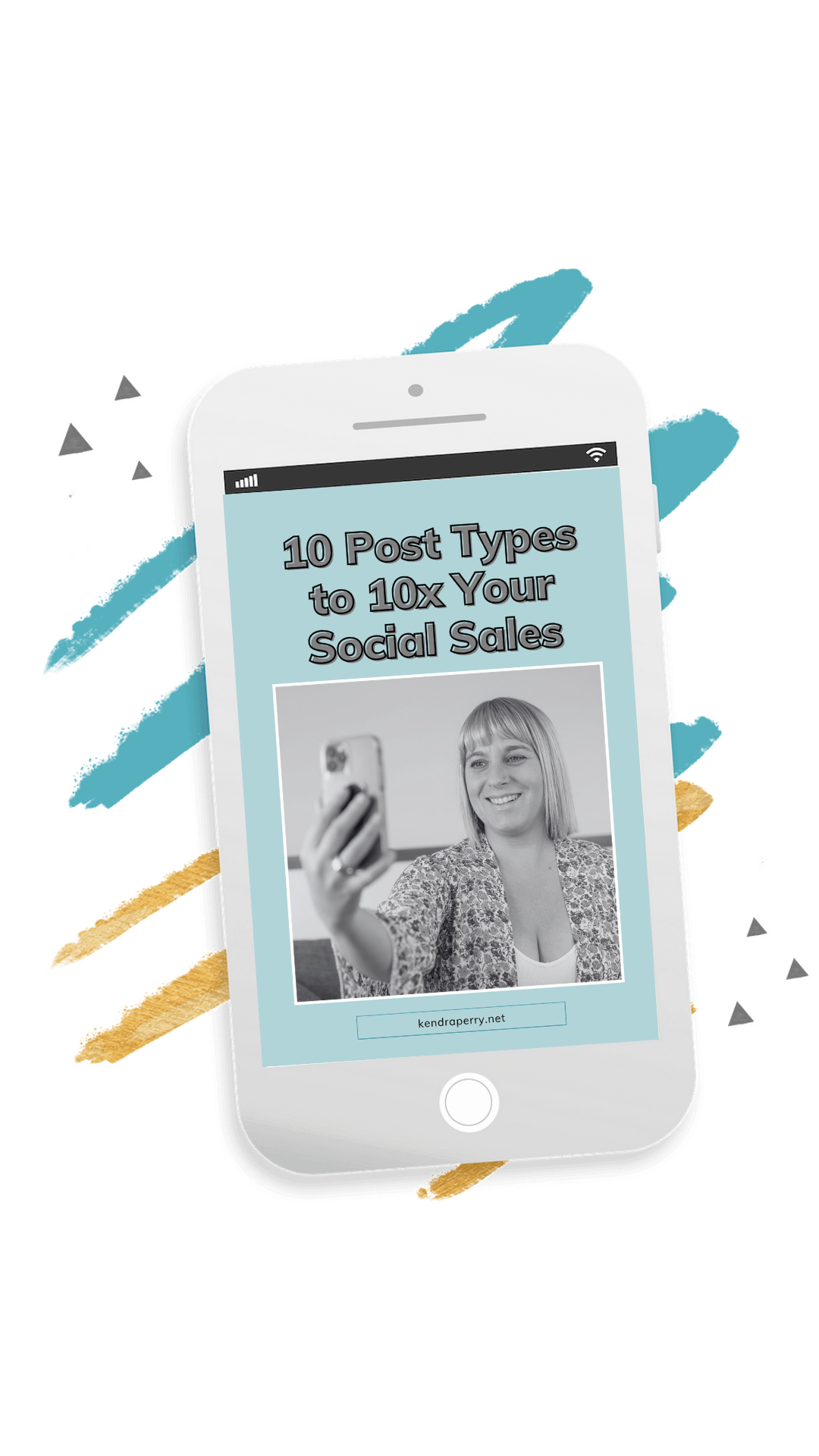More and more are discovering how webinars can be a powerful sales tool. However, you just might be missing out on its benefits by falling into the common pitfalls. In this episode, Kendra Perry dives into the three common webinar mistakes most health coaches make that affect your sales. Her discipline and framework prove to attract and convert viewers into clients. Kendra also offers insights on how “giving more” won’t market your service and attract clients. What should you do instead? Tune into this episode to learn and avoid these common mistakes.
Get a free biz audit: DM the word ‘biz audit’ to Kendra on Facebook or Instagram.
Watch Kendra’s free training: How to Attract & Convert Dream Clients, Master Your Marketing so you can Enroll Your Next 3 Clients.
Give this podcast a 5-star review: https://ratethispodcast.com/wealthy
—
Listen to the podcast here
Three Webinar Mistakes Every Coach Makes
I’m in a good mood because I had an amazing weekend. If you don’t want to hear about my freaking awesome hiking trip, you can fast-forward. Maybe you don’t care. I know some of you guys love to hear about my adventures. I get a lot of questions and comments on my Instagram. It’s the middle of August 2023 at the time of this episode and there is this place. It is this beautiful little basin surrounded by so many glaciers. Literally, you were surrounded by glaciers.
It’s not an easy place to get to. There’s no sanction trail. There isn’t a trail in general. You got to do a bit of road-finding. You got to know where you’re going. Funny enough, a few years ago, me and my partner Ryan decided to go to this place. I’m not going to say the name of it because I want to keep these places secret, but we’ll call it Glacier Paradise. Essentially, Ryan had learned about it. I think he’d found a trip report. You can get there by going to this popular hiking spot. You keep going and traverse around this mountain. You have to go to this boulder field and over this sketchy pass.
It took us a long time to get there. It was very hot. We hiked up the sanctioned trail part, the popular zone where there is a legit hiking trail, but then we had to drop down. We had to go around this rock face. We were climbing helmets not because we were rock climbing but because of rockfall. We wanted to be safe. It took a long time to get there and then at the end, you have to go over this steep loose, crumbly slope which is a no-fall zone. Let’s be honest. If you fell and went down, you would die. It’s a no-fall zone but I was fine with it. I’m okay with a little bit of exposure.
It was definitely sketchy and it took us a long time to get there. We got there as the sun was beginning to go down. When we came over this little pass, we saw a glacier paradise. It’s so beautiful. If you check me out on Instagram, you might be able to see some of those photos, but you have this big mountain in glacier right in your face with these beautiful turquoise lakes right at the bottom. It’s a boulder field, but then there are these terrace ledges. This thing called bear grass which is this thick spongy grass and it’s in your face.
The colors are insane and the rocks are literally purples and pinks. They’re these beautiful pastel colors and there’s this cool lichen on all the rocks. It’s honestly beautiful. When we went there, it was a hot summer. I remember it was a big fire season, so there were fires burning off in the distance so there was a bit of smoke in the sky. We went to sleep. The next morning, we woke up and it was fully sucked in with smoke. You can’t see anything. We sat in our tent and read and then the rain came. It was cold and rainy.
There was a little window where it stopped raining. We went and walked around, but you couldn’t see anything. The next morning, we woke up and it was perfectly clear, but we had to hike out, and it was a very long hike. It probably took us about five hours in total each way to get there. When we first got there and came over this past, we’re like, “That was so long. That was crazy.” We looked into the distance and in the grassy meadows, there are literally two children playing in the meadows and we were like, “What the f***? Who would bring their children here? That is a long hike and also it was pretty sketchy.”
While we were there, we ended up going over and talking to them because we were interested. We’re like, “Who is this family who brings their children over such a sketchy hike?” When we talked to them, they said, “There’s another way in. You can come up this other drainage or other valley and there’s this easy trail that we’ve maintained over the years.” The guy was a researcher. He’d researched the golden larches in the area. He was in conservation or something, so he knew the area. We’re like, “Okay.” We became obsessed with finding this alternative route. I believe it was two years later, we got a group of people together, and we tried to find it, but we had very little beta. We were going off with these people and said, “They said there was a trail. It was pretty obvious it was easy.”
We did find the trail. We went to an entirely different access point and this other row was very narrow, but luckily, Ryan has an older small truck, which is great for backcountry roads. He doesn’t care about scratching up his truck because it’s old anyways. It doesn’t matter. It is narrow so it’s good when the roads are not in the best condition. It would be worse to have a wider truck. We ended up doing a bunch of bushwhack and we finally found this trail. We hiked up to this big wall of rocks. I remember we could see it from where we parked and we’re like, “Where do we actually go?”
We ended up going to this point. We saw a space where we could get over, but it was a little bit of a scrambling move. Scrambling is when hiking gets a little bit steep where you don’t need a rope, but a lot of people probably wouldn’t feel comfortable without a rope. People in our party were like, “We’re not comfortable doing that.” When we go hiking and do anything like that, if there’s one person at the party who’s not comfortable, we turn around. That’s how it goes. We didn’t want to make anyone uncomfortable. We couldn’t figure out where it was and what we kept coming back to, “That was this steep move, but that 7 and 9-year-old.” For years, we have been obsessing over it and we’ve looked at maps. We’re like, “Where is this route?”
Finally, we went up with a couple of friends. One is a very hardcore badass rock climber, who does some pretty big stuff. His girlfriend is very capable as well. She’s not quite as hardcore. She doesn’t do the big stuff, but there were the right people to go out with. This time, we didn’t have to bushwhack. We knew exactly where to park and where the little trail started. It’s this easy trail. It’s flagged. It’s not a wide hiking trail but it’s there. Obviously, people use it. We walked up the valley, got to the base of this headwall, and went up to that move again. We went over it. It was sketchy. I have to say that I didn’t like it. It was right on the edge but we got above it and then we were on this steep wet slope that we had to scale up.
We had to cross this creek. We’re in this boulder field and there’s this creek. We’re like, “How do we cross this?” It was decently steep. We had to build a bridge with boulders and finally, we were able to get past that and find an area that was easy to climb over and get into Glacier Paradise. We were tired. It took us about four hours. We felt like we didn’t save much time, but again, that was pretty hardcore. We’re like, “Why would this family tell us that it was easy and the 7 and 9-year-old?” We kept coming back to it. We were thinking about going back down because we spent a couple of nights there. It was honestly amazing.
We had perfect weather. We were able to hike around and see some of the most amazing views. It’s literally one of the most beautiful places I have ever been in my life and pretty special because most people will never go there. Most people would never feel comfortable going off the trail like that and route finding. That makes it extra special. We were thinking about it because going up something is sometimes not too bad, but going down is always the issue. I was like, “I’m not feeling excited about going down,” but as we were going up, we saw that there was this whole tree patch. We’re like, “I bet we can go down in those trees.”
Luckily, we have this amazing app. It’s called FATMAP and it’s so good. It’s better than the app Gaia. If you’re in the mountains, it gives you all these different layers and aspects. You can see the slope. We looked at that. We figured we could go down. We started navigating this route down through the trees and it turned out to be very easy and short. We found a flag line and we’re like, “This is where the family went up.” Now, it was still steep but it was totally doable. If you had children that you raised to be hikers and they were used to that, then it would be fine. Finally, we found the way and it turns out through these trees.
It was steep but the way the landscape is like this spongy bushy grass stuff. It’s almost little steps. When you’re going down, you go slow. When you’re going up, you take baby steps up. It only took us about under two hours to get back so it was fast. After all these years of obsessing over this back route in, we found the easiest way and it’s amazing. I feel grateful. We finally understand how this family was able to get in there with these children. I feel grateful and happy and I have that after-hike glow right now. For any of you, if you guys do adventures or hiking, when you hit an objective that you’ve wanted to hit for many years, it’s a very fulfilling feeling. Enough about my hiking adventure.
I want to talk about webinars and some of the most common mistakes that basically every coach is making. I will include myself in this. Let’s get on the same page. A webinar might be called a masterclass or training. What I believed a webinar was when I first got started was this presentation where I taught some stuff and then I pitched my program at the end. The big distinction or mindset switch that I had to make with webinars in order to become good at them was to realize that It’s a sales video. That’s what a webinar is.
Teaching On The Webinar
You give value and people walk away feeling like they got something out of that. Sometimes, their whole belief system is shifted. They get an insane amount of value out of a webinar but the intention is always to sell. If you don’t understand that or you’ve never taken a course or training in webinars, you were likely going to be making all three of these mistakes. The first one is a doozy, and this was one that I made up until a couple of years ago when I started doing webinars. I believe I did my first one in 2015 or 2016. That is teaching too much.
The first mistake is teaching on the webinar, which you might be thinking, “Isn’t that the point? Shouldn’t I be teaching?” Actually, the goal is not to teach. The more that you teach, the less sales that you make. The reason for this is when we dive too much into the how-to, the nitty-gritty, or the details, what we’re giving the viewer is a piece of the full picture. Typically, a webinar is going to be about an hour. Maybe a little bit more or a little bit less. You can’t teach them everything they need to know in an hour. You’re giving them the small picture of what they need to know.
They think they have enough, but when they go out and execute it, because they have an incomplete piece of the full picture, they don’t succeed, and that does them a disservice. We don’t want people to walk away from a webinar feeling like, “I have everything I need,” because they don’t and they can’t. You can’t teach them everything they need to know in that short amount of time. The goal of a webinar is not to teach. It’s to shift beliefs or paradigms. Instead of teaching them how to do something, you are shifting some common beliefs that are keeping them stuck. This is definitely a little bit of a mindset shift. When I learned and realized this about webinars, I was scared.
I was like, “If I put this webinar out there and I’m not teaching them how to do anything, I’m shifting these beliefs. Are people going to find this valuable?” The first time I ran my webinar, I was so nervous. I’m like, “People are going to be like, ‘This sucked. I didn’t get anything out of it.’” What happened was I got more positive feedback than I had ever gotten on a webinar before. I had people reaching out to me being like, “That was the most valuable webinar that I have ever watched. Thank you.” The goal is not to teach. We want to shift common beliefs or industry myths that are keeping them stuck.
This is still incredibly valuable to them. Think about it. If they believe one thing and they’ve been doing this one thing and it’s not working, they think, “I can’t get XYZ result because I’ve been doing this one thing that everyone tells me to do and it’s not working.” They then are going to be stuck. If you tell them, “That’s not true. That’s a lie or BS,” or whatever you’re saying, it sets them free. What we want to do is we want to shift that belief system so that they can be free to try a new way. At the end of the webinar, you present your program as the solution.

I’ll give you an example. Let’s say you’re a weight loss coach and you help women in their 40s lose 30 pounds or something like that. I’ll use a very common paradigm. A very common belief is that in order to lose weight, you need to eat less and exercise more. Most people believe that. They’re doing that but it’s not working, or maybe it worked a little bit but then they gained all the weight back because they couldn’t stick with that. Your goal wouldn’t be to show them how to, what to do instead, and all the nitty-gritty details. You would shift that paradigm. You would tell them like, “You’ve probably been told that in order to lose weight, you need to eat less and exercise more.” Now I’m going to make up some things that you may or may not believe but I’m just trying to prove a point.
You tell them, “That’s not true. If you’ve been following this, it’s no wonder you’ve not been able to lose weight.” You state the thing. You tell them that it’s not true and then present evidence to show them why. Maybe it’s something like, “The majority of studies that look into this are done on men, but you are not a small, tiny man. You are a woman in your 40s with a totally different hormone profile than a man. While this will work on men, it won’t work on women in their 40s. It may have worked in your 20s because of XYZ and your hormones look like this but now you’re in perimenopause, etc.”
You are essentially setting them free from a belief that has been holding them back and keeping them stuck. You’re showing them. “We have to do this instead.” You’re not going into the details about how to do that and what that looks like. You can imagine how that could be pretty valuable to someone who continually tries to starve themselves, exercise more, feels like s***, isn’t losing weight, and is incredibly frustrating. You are standing there being like, “That’s BS advice. It’s no wonder you’ve been following that because everyone is telling you to do that. This is why you’re not losing weight.” You can imagine you’d be like, “No wonder.” An example from my webinar. A belief that I shift is that it’s easier to sell something lower price.
A lot of my people are out there either charging hourly or they’re selling some low-price program or course. They’re not making money. They’re making maybe $1,000 a month. They’re struggling but the belief is, “If I keep hearing that it’s too expensive, I need to charge less and I’ll sell more. More people will be more enticed to buy if I charge less.” This is a myth and people are going to object to pricing at any price. I once had someone tell me that a $27 workshop was too expensive, which is crazy. If people are going to tell you they can’t afford it anyways, you might as well charge more. What I do is I show them that the reason why they’re not successful in selling this low-price course is because they don’t have the traffic to support it.
Any business model can be successful. You can still sell something cheap but you need to have the traffic because you’re going to need a higher volume to hit your goals. The majority of my audience has small social media followings. They’re not ready to invest in paid ads and to sell something lower ticket or cheap is impossible. They’re going to need hundreds of people to see that offer each month to make the sales that they want to make. Where is the traffic going to come from? I shift that belief and present the alternative as the high-ticket program.
Why do I do that? In HCA, we very much focus on selling a high-ticket program. I’m not teaching you how to sell low-ticket courses, a membership, or a package of sessions. I’m teaching you how to sell one high-ticket program. The beauty of this is we only need to make 2 to 4 sales a month to hit our income goals. Hopefully, you can see how shifting that paradigm sets someone free from the thing they’ve been stuck in that’s preventing them from getting results. We don’t want to teach on webinars. We want to shift beliefs.

Webinar Is Too Long
That’s a big one. That’s a doozy. That literally changed the whole way I looked at webinars. When I made that shift, my conversion instantly tripled. It was crazy. I was so worried that people weren’t going to find value in it but they found way more value in it than in any of my other webinars that focused on teaching. Mistake number two is that the webinar is too long. Webinars are truly an art. The goal is to say what we need to say in as little time as possible. More is not better. People don’t have a lot of time. They have short attention spans. People aren’t going to sit down for two hours and want your webinar. Typically, the shorter, the better.
If you could get your webinar to 30 minutes, that would be fantastic. Ultimately, we need to track. Sometimes, a longer webinar might work for one person whereas a longer webinar might not work for another person. I remember talking to a student once who had come to HCA. She said, “I have this webinar and it’s two and a half hours long.” I was like, “No one is going to get through that because, truthfully, people are going to get distracted.” When it comes to webinars, coming back to what we said at the beginning, a webinar is a sales video. It provides value and can change someone’s life and their whole perspective on what they’re doing.
It can be incredibly valuable but if the person never gets to the pitch at the end where you try to sell your program, what’s the point? We want people to get to the end. That’s why a shorter webinar is technically better. The type of webinar you’re doing matters. With the live webinar, you can get away with a bit of a longer webinar because, with a live webinar, there’s more energy. There are people on live. You’re usually engaging with people and you’re answering questions.
That is going to take up more time, and the webinar will be longer versus automated webinars. It’s something that is pre-recorded. Whether I would not be on there live, I have a pre-recorded webinar. That has to be shorter because the energy is not there and if you are babbling on forever, then people are going to get distracted and they’re never going to watch it. A lot of people make their webinars way too long. Hundred percent I did this. My Evergreen webinar was an hour and a half at one point. My live webinar was almost two hours. It was challenging for me to condense it because we always have a lot to say and it’s always harder to say what we want to say in less amount of time.
Not Knowing The Numbers
It’s an art to be able to get our point across in less time. That’s number two. The webinar is too long. Number three is not knowing the numbers. This is a big one. A lot of people hear or see that people are doing webinars. They’re like, “I’m going to do a webinar too.” That’s great but if they don’t have the traffic to support a webinar, it might not even make sense to do a webinar yet. There is an important number. This is for any event that you do but this is important for webinars. It applies to webinars. It’s called the Lead-To-Sales Conversion. What this means is it is the percentage of people who buy based on the number of people or leads in the event.
In this situation, the lead event would be the webinar. Let’s say 100 people signed up for your webinar and 2 people bought. Your lead-to-sale conversion would be 2%. It is sales divided by the number of people in the event expressed as a percentage, so times 100. This would apply to anything. This could be used for a challenge. Let’s say you have 100 people in the challenge and 3 people buy. Your lead-to-sale conversion will be 3%. This is an important number to know because this will help you determine if doing a webinar is something that is even available to you at this point in your business or if you need to get more leads to your email list.
A good lead-to-sale conversion for a webinar is 2% to 5%. That would be the industry standard. Can it be higher? Absolutely. Can it be lower? Absolutely. When you’re new to webinars, maybe you’re thinking about doing one, always trend on the lower side because you’re not going to hit the webinar out of the park on the first try for the most part unless you have a good coach, you have a good script, you potentially could. Usually, we’re going to start at the lower end and improve our messaging and webinar over time as we test it. Let’s say I get a lead-to-sale conversion of 2%.
What that would mean? You’d have to figure out or reverse engineer this. You’re like, “My program is $2,000 and I want to make 4 sales and make $8,000 off of my webinar.” What would that be? That would mean that you would need 200 people because a 2% lead-to-sale conversion with 200 people in a webinar would be 4 sales. You’re like, “I need 200 people to register for this webinar.” You have to ask yourself, “Where are those 200 people going to come from?” Let’s say you only have 200 people on your email list but you’ll never get 100% of them to sign up for a webinar. You might get maybe 5 of them to sign up for the webinar or up to 20. When I run a webinar, about 5% of my email list will register for the webinar.
When I’m on a webinar, I will get anywhere from 5% to 10% of my email list registering for that webinar. These are good numbers to know and you’ll learn these over time. Let’s say I have 200 people and I get 5% of people to register for a webinar, that’s 10 people. If you get 10%, it’s 20 people. I’m going to have a 2% lead-to-sale conversion. If I only have 20 people on my webinar and I have a 2% lead-to-sale conversion, that is not even a percent. That’s 0.4 of a sale. Hopefully, you see where I’m getting at here. Numbers matter but what this can help you is determine, “How much do I need to build my email list to be able to start considering webinars as my business model?”
Let’s say 5% of people sign up from my list, you can reverse-engineer this. Let’s pretend I’m going to do a webinar. I’m going to aim for a 2% lead-to-sale conversion. That means if I get 200 people to register for my webinar, I should be able to make 4 sales. Let’s say I’m aiming to get 5% of my email list to register for that webinar, how many people is that going to be? You can pull out your calculator, but the calculation we need to do is we would need to take 200 and divide it by that conversion of 0.05. That’s 4,000 people. Interesting.
You’re going to need about 4,000 people on your email list in order to get 5% of those people, register for a webinar, get 200 people into the event, and make those 4 sales. Could it be higher? Absolutely. Sometimes I get 10% of people to register for a webinar, and I would only need 2,000 people on my list in order to do that. Sometimes if you have a very engaged list, you might even get more of those people to sign up. Maybe you can get a 5% lead-to-sale conversion. Sometimes I’ve had a lead-to-sale conversion as high as 12%. Obviously, these numbers vary a lot. I’m giving you averages and industry standards so you can get in an idea.
This is important because a lot of times, we do something and we’re like, “I did this and no one signed up for my webinar. I’m doing something wrong,” when you might not be doing anything wrong at all. Maybe you don’t have the right number of people on your email list. What this could do for you is you’re like, “I want webinars to be my business model. I don’t want to use sales calls. I want to sell them webinars.” It’s great. You need to start building your list. You need to start thinking, “How am I going to build my list?” Maybe you have a huge TikTok following or a big Instagram following and you are constantly getting new people onto your list.
You can make an Instagram Reel and flood your list with new leads. That’s great but that’s not going to be a reality for most of us. A lot of us are going to need to do something like paid ads. We’re going to start to run paid ads to start building our list to get to the point where we can start to consider running a webinar. In the first webinar that I did, I had 1,000 people on my list and I did manage to get about 100 people to sign up, which is great. I didn’t convert anyone because my webinar was terrible and it focused all on teaching. I didn’t know anything.
I was super ignorant so I didn’t get the sales but I had about 1,000 people on my email list and I did manage to get over 100 people to register for the webinar, which is very exciting. If I had done a 5% lead-to-sale conversion, I would have made five sales, which would have been great. These are something to consider. Another thing I want you to consider is if your webinar is live versus Evergreen, which is automated, it’s on-demand, and you can get it whenever, there’s a big difference in the numbers.
Typically, when you do something automated, that lead-to-sale conversion will be cut in half. Let’s say you are getting a 5% lead-to-sale conversion with your live webinar, which is great. If you’re thinking, “I’ve done this live webinar bunch of times. I want to turn it automated so I don’t have to do it live all the time,” your conversion is going to drop maybe in half or even more. With my Evergreen webinar right now, my conversion is about 1.5%. I’d like to make it higher. I’m working on that. Something to keep in mind is a lot of people love the idea of passive sales.
They’re like, “I’ll record this webinar. I’ll make it automated and then it’s going to sell my program while I sleep.” That could happen but again, we have to think about this traffic piece. You can imagine that if you only have a 1% conversion and your goal is to make ten sales a month, you’re going to need a lot of traffic. If I want to make ten sales per month and I’m only getting a 1% conversion, I’m doing the math right now. What I’m doing is I’m dividing 10 by 0.01. That’s 1,000. That means I need 1,000 people every month to register for that automated webinar if I’m going to make those 10 sales.
You’re like, “A thousand people a month, where are those people going to come from? I have a small social media following. I can definitely grow my email list.” You could run ads that automated webinars, but you have to imagine you’re going to have to pay for it. I tend to pay about $10 per lead. For me, I’d have to spend about $10,000 a month to get people to that webinar. If I was selling at 1.5%, that would be about $20,000. It’s not exactly the profit margin I’d want. I’d want to higher profit margin, but I would still make $10,000. Spend $10,000 to make $20,000. It’s a pretty good deal but it can be scary to spend that money. This is why it makes more sense to run ads to a lead magnet and get a cheaper cost per lead to grow your email list and then do a live webinar.
It’s important to know the numbers when you’re doing webinars because a lot of people will do things and say, “They don’t work,” but it’s because they aren’t educated enough to know that they needed more people. Again, if you need to make 5 sales but only 50 people register for your webinar, there’s a good chance you’re going to make zero sales. It doesn’t mean that your webinar sucks. It could. You could be teaching too much, but it could be that you don’t have enough people registering for the webinar. There’s a lot that goes into that. Let’s quickly summarize that. The biggest mistake that people make by far, I made this mistake for years, is teaching too much on the webinar.
You don’t want to teach but shift paradigms and beliefs. The biggest ones that are keeping them stuck and then you shift it. You present your program as the new way or as the solution mistake. Number two is making a webinar that is too long. Again, this speaks a little bit to mistake number three. We got to look at the numbers. What is too long for me might not be too long for you but what you can do is there are webinar software or platforms. We can track where people are dropping off. If your webinar is 60 minutes and you get to the pitch at 40 minutes but everyone’s dropping off at 25 minutes, then the webinar is too long.
You know that you need to get to the pitch in 25 minutes. You’ve got to know the numbers, which is a mistake number three, not knowing the numbers. To make a webinar work, you have to be willing to track numbers and look at all the moving parts, especially when we’re talking about automated or it’s not going to work. Sometimes, we think something doesn’t work, but if we looked at the data, it would be the other thing that didn’t work. You might think, “I need to do this whole new webinar,” but your webinar is a bit too long and you need to get to your pitch a little bit sooner.

I hope you enjoyed this episode. I loved hanging out with you. If you loved this episode and you want to support the show in a way that will literally only take three seconds, make sure you’re subscribed to this show on Spotify, Apple Podcasts, or wherever you’re tuning into your show. Download the last three episodes because that alone, which only takes you three seconds, is a great way to support me. If you love this content and want to go one step further and maybe spend a couple of minutes supporting the show, you can go to RateThisPodcast.com/Wealthy and give the show a five-star review. I hope you have a lovely rest of your day. I will see you next episode. Same place, same time, where I help you become wealthy AF.
Important Links
- Instagram – Kendra Perry
- FATMAP
- Gaia
- http://Facebook.com/KendraPerryInc
- https://go.KendraPerry.net/Training
- https://RateThisPodcast.com/Wealthy




![[BEST OF] How To Stop Creating Boring Ass, Snooze-Fest Content For Social Medias, Snooze-Fest Content For Social Media](https://kendraperry.net/wp-content/uploads/2025/04/Podcast-Design-Horizontal-Audiogram-58-300x169.png)

